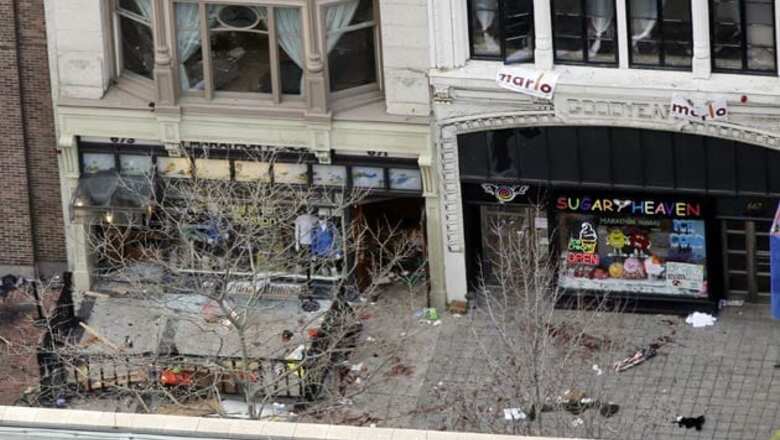
views
Boston: Authorities suspect whoever perpetrated the Boston Marathon bombings carried heavy devices made out of pressure cookers in dark-colored nylon bags or backpacks before dropping them near the finish line, causing the worst attack on US soil since September 11, 2001.
The twin blasts on Monday killed three people including an 8-year-old boy and injured 176 others, some of whom were maimed by bombs packed with ball bearings and nails.
President Barack Obama, who will travel to Boston on Thursday for a memorial service, on Tuesday called the bombings an "act of terror" and police said parts of central Boston could be closed for days.
Other cities across the United States were watchful following the worst attack in the country since the 2001 hijacked plane attacks. Suspicious bags were inspected at Boston Logan International Airport and La Guardia airport in New York.
In Washington, a US Senator said that an envelope sent to another senator tested positive for ricin, a potentially lethal poison.
At the scene of the marathon, investigators recovered material that was being reconstructed at the FBI laboratory in Quantico, Virginia, said Richard DesLauriers, the Federal Bureau of Investigation's special agent in charge for Boston.
"Among items partially recovered are pieces of black nylon which could be from a backpack and what appear to be fragments of BBs (ball bearings) and nails possibly contained in a pressure cooker device," DesLauriers told a news conference.
"This morning it was determined that both of the explosives were placed in a dark colored nylon bag or backpack. The bag would have been heavy because of the components believed to be in it," DesLauriers said.
No suspects were in custody and there were no claims of responsibility.
"The range of suspects and motives remains wide open," DesLauriers said.
US Homeland Security Secretary Janet Napolitano said there was no indication that the bomb blasts were part of a broader plot.
LONDON AND MADRID MARATHONS REVIEW SECURITY
Officials in Britain and Spain said the London and Madrid marathons would go ahead on Sunday, but security plans for both races were under review.
Much of central Boston remained cordoned off on Tuesday surrounding what Police Commissioner Ed Davis called "the most complex crime scene that we have dealt with in the history of our department."
Doctors listed 17 of the wounded in critical condition and said some would have to endure several operations over the coming days.
"When these kids came in ... they were just so badly hurt, just covered with singed hair and in so much pain, it was just gut-wrenching," said David Mooney, the director of the trauma program at Boston Children's Hospital. "Pulling nails out of a little girl's flesh is just awful."
Another doctor said he was amazed by the resolve of the patients.
"Some of them woke up today with no leg and they told me that they are happy to be alive. They told me they thought they would die as they saw the blood spilling out," George Velmahos, chief of trauma surgery at Massachusetts General Hospital, told reporters.
The decision to amputate was easy, he said: "We just completed the ugly job that the bomb did.
DEAD AT 8 YEARS OLD
The youngest to die was an 8-year-old boy, Martin Richard, who lived in the city's Dorchester neighborhood. Outside the family's home, sympathizers created a makeshift memorial of flowers and "Peace" was written in chalk on the sidewalk.
Officials identified a second person killed as Krystle Campbell, 29, of Medford, Massachusetts. She was "the daughter that every father dreams to have," said Medford Mayor Michael McGlynn, who said he had confirmed the death with Campbell's father, William Campbell.
"She had a great sense of humor and freckles and red hair that brought her right to her Irish roots," McGlynn said.
Officials had yet to release the identity of the third person killed.
At least one bomb and possibly both were built using pressure cookers as the superstructure, black powder or gunpowder as the explosive and ball bearings as additional shrapnel, according to current and former counterterrorism officials briefed on the matter.
The sources, who asked not to be identified, said instructions on how to design such bombs are available on the internet.
Trauma surgeons at several Boston hospitals told reporters a number of victims had metallic shrapnel material removed during surgery, including pellets and what appeared to be nails, which would make the device reminiscent of the 1996 bombing at the Summer Olympics in Atlanta, which killed two people and injured about 150 others. Anti-abortion activist Eric Rudolph, who eluded capture for years, pleaded guilty to that attack and is serving consecutive life sentences.




















Comments
0 comment